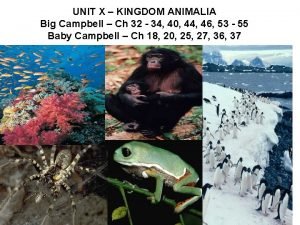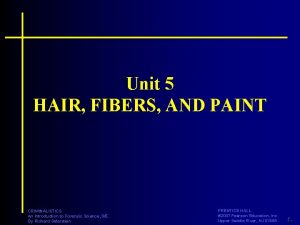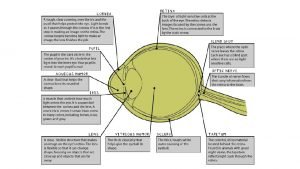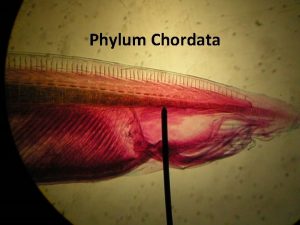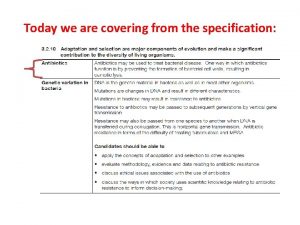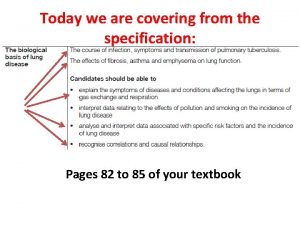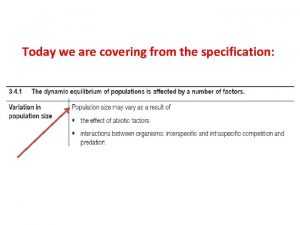Today we are covering from the specification What
































- Slides: 32

Today we are covering from the specification:

What is classification? • Organising living organisms into groups • We need to do this as scientists have already named around 1. 8 million different living organisms. Look at the specimens and arrange them into groups. • How did you decide on the groups? • What different methods of grouping can you think of?

What is a species?

What is a species? • A group of organisms that are similar to each other but different from members of other species. • Similar genes, similar physical and biochemical characteristics • Similar developmental patterns and immunological features • Occupy the same niche

• Members of the same species can breed with each other to produce living, fertile offspring • A full set of genes from any individual can be combined with that of another individual if they are of the same species.

What is a species? • Members of the same species can breed with each other to produce living, fertile offspring • Rarely, different species can interbreed but their offspring are infertile.

Mules and Hinnies

Liger (male lion and female tiger)

Tigon (female lion and male tiger)

How do we name a species? • Used to be due to certain features of the organism • No continuity across the world • 200 years ago Linnaeus (a Swedish botanist) came up with a universal system

The Binomial System • Uses Latin or Greek names • The first name is the generic name and this is the genus to which the organism belongs – (Similar to the surname of a person) • The second name is the specific name and this is the species. – (Similar to the first name of a person)

Canis lupus Equus caballus Protea caffra

The Binomial System: Rules • The specific name is never shared with another species within the genus. • The names are printed in italics or underlined if hand written. • The first letter of the generic name is capitalised, and the specific name is not.

Principles of classification • The grouping of species is called classification, whereas the practice of biological classification is called taxonomy.

Types of classification Artificial classification: • Divides organisms by physical characteristics, such as size or number of legs. • Describes by the same function, not the same evolutionary origin. • What are the problems with this?

Types of classification Natural classification: • Based upon evolutionary relationships. • Classifies species using shared features derived from their ancestors. • Arranges the groups into a hierarchy – groups contained within larger groups with no overlap


Taxonomy Each group within a biological classification is called a taxon (pl. taxa). The largest is the kingdom.

Taxonomy • Each group within biological classification is called a taxon. • The largest is the kingdom. • The largest group in a kingdom is a phylum.

Taxonomy • Each group within biological classification is called a taxon. • The largest is the kingdom • The largest group in a kingdom is a phylum. • Within phyla there are classes.

• • Classes are then sub-divided into orders Orders are divided into families Each family is divided into genera (sing. = genus) Each genus is divided into species


King Prawn Curry Or Fat Greasy Sausages? Keep Ponds Clean Or Frogs Get Sick! Rank Kingdom Phylum Class Pin mould Fungi Zygomycota Zygomycetes Sweet Pea Plantae Angiospermophyta Dicotyledona Tiger Animalia Chordata Mammalia Order Family Genus species Murolales Muroraceae Murcor mucedo Rosales Fabaceae Lathyrus odoratus Carnivora Felidae Felix tigris

Phylogeny • This is the evolutionary relationship between organisms. • The phylogeny reflects the evolutionary branch that led to the organism. • Usually shown as a tree like diagram, a phylogenetic tree.


Homework Complete the following sections of your Unit 2 booklet to hand in on Friday: - Natural selection and genetic diversity - Investigating variation

To do: • Create your own model of a phylogenetic tree • Arrange the objects into an evolutionary tree (make sure you follow the rules!) • Once you have finished, you can glue the pictures down. . . • Draw lines in between! • Be prepared to justify your choices. 20 minutes

Problems defining species… • • What should you do about different breeds of dog? Species are not fixed Many species are extinct Some species are sterile…

Exam Questions

The mule problem…

Learning Check! Self assessment 1. a. Green Monkey (1 mark) Because it’s the closest to humans on the tree. (1 mark) b. Pig (1 mark) 2. A group of similar organisms (1 mark) able to reproduce to give fertile offspring. (1 mark) 3. Max 5 marks available, 1 mark for each correct answer Kingdom Phylum Class Order Family Genus Species Animalia Chordatia Mammalia Primates Homidinae Homo sapiens 4. Max 3 marks available. E. g You can’t study the reproductive behaviour of extinct species (1 mark) Some species reproduce asexually (1 mark) There are practical and ethical issues involved in studying some. reproductive behaviour (1 mark)

You should be able to… • Define what we mean by a species • Explain the system of naming species • Outline the principles of classification – Natural classification and artificial • Explain what is meant by taxonomy and phylogeny • Be able to interpret a phylogenetic tree
 Insidan region jh
Insidan region jh If lclp is negative number, we set the lclp = 0. why?
If lclp is negative number, we set the lclp = 0. why? Natural variations operations management
Natural variations operations management Today's lesson or today lesson
Today's lesson or today lesson There is class today
There is class today Example of repitition
Example of repitition Proposal kickoff meeting agenda
Proposal kickoff meeting agenda Galton details
Galton details For today's meeting
For today's meeting Sample letter for placing an order
Sample letter for placing an order Coronal hair pattern
Coronal hair pattern Spermatic cord coverings
Spermatic cord coverings Phylum chordata
Phylum chordata Signed statement for head covering
Signed statement for head covering The scale structure covering the exterior of the hair
The scale structure covering the exterior of the hair Non chordata
Non chordata What does the medulla do in hair
What does the medulla do in hair Coverings of the brain
Coverings of the brain Flexible covering of an animal cell
Flexible covering of an animal cell Two week notice letter example
Two week notice letter example Double layered membrane
Double layered membrane To safely transport cargo use
To safely transport cargo use Fibroareolar sheath
Fibroareolar sheath Membrane covering the heart
Membrane covering the heart Coverings of the spermatic cord
Coverings of the spermatic cord How tough is the cornea
How tough is the cornea Floor covering weekly top 50
Floor covering weekly top 50 Oolab shoes
Oolab shoes Cigna not covering vitamin d testing
Cigna not covering vitamin d testing Tetrahedral holes in fcc
Tetrahedral holes in fcc Platyhelminthes notochord
Platyhelminthes notochord Foil algorithm in machine learning
Foil algorithm in machine learning Liar in cursive
Liar in cursive












